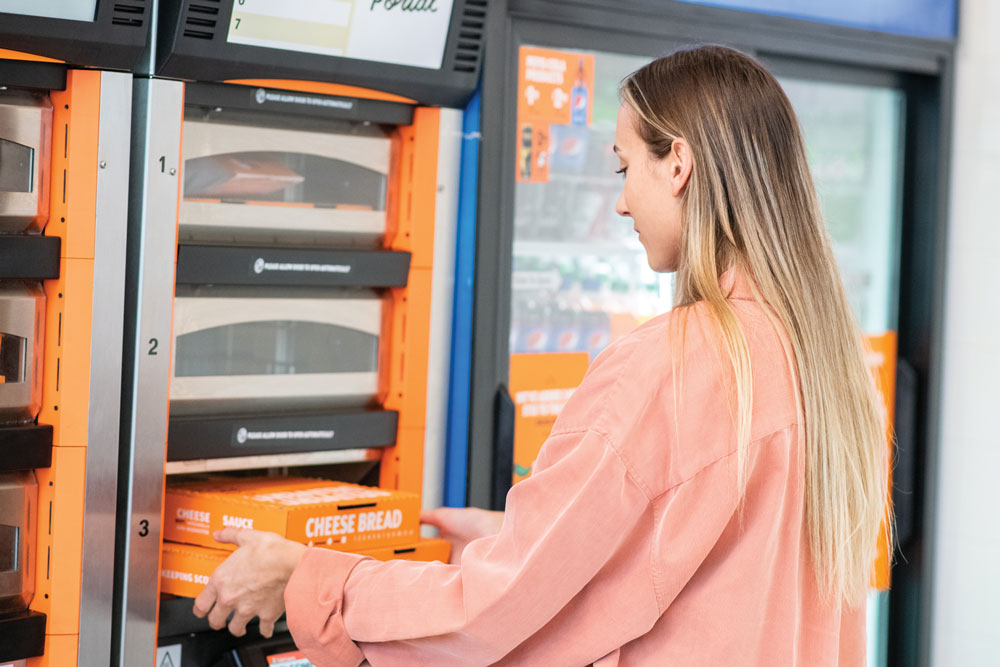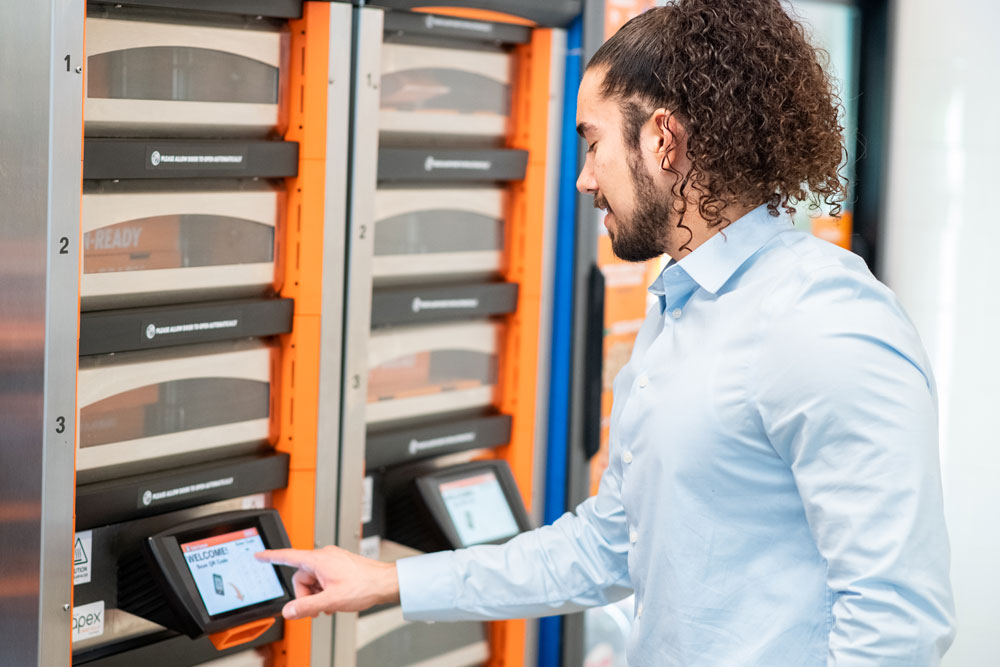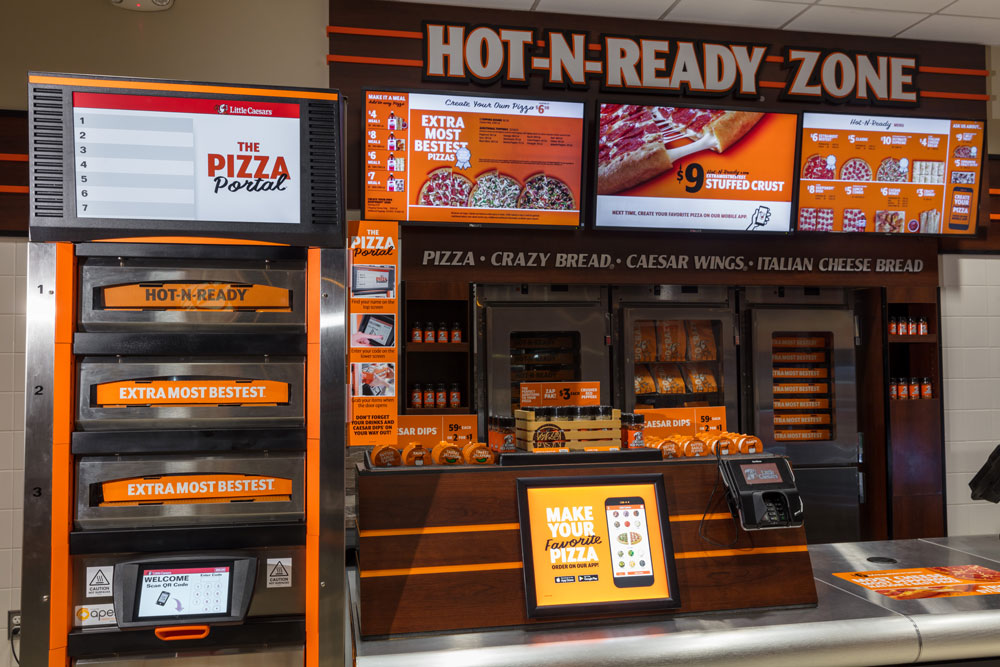By Tracy Morin
While pizzeria owners pride themselves on providing the personal touch to customers—even when handling to-go orders—there are many people today who would rather not interact with human beings in the course of ordering and retrieving their food. And it’s these types of customers who are most likely to take advantage of food pickup lockers installed in pizzerias—technology that major brands like Detroit-based Little Caesars are investing in.
“Little Caesars has a legacy of innovation, and we are always focused on how to make customers’ lives easier,” explains Patrick Cunningham, vice president of U.S. development. “We revolutionized the pizza industry nearly 20 years ago with the introduction of Hot-N-Ready, and the Pizza Portal pickup—the first heated, self-service mobile order pickup station in the restaurant industry—was a natural next step.”

The Pros of Pickup Lockers
Cunningham notes that through this innovation, which was launched in 2018, Little Caesars execs wanted to combine the convenience of mobile ordering and pre-payment with heated self-service pickup to create a new experience for QSR customers, offering guests value, convenience and quality. “Through direct-to-consumer marketing, as well as in-store, digital and TV advertising, along with PR, we quickly spread the word, and our nationwide rollout was extremely successful,” Cunningham adds. “Our proprietary Pizza Portal pickup is now available at nearly all North American locations.”
Mary King, an independent-restaurant adviser and senior staff writer for restaurants at Fit Small Business in New York, believes that pickup lockers are helpful for pizzerias, too—and they’re not just for hurried customers who want to grab and go. “They’re a great way for independent pizza shop owners to expand their sales without increasing labor costs,” King says. “And, as with any digital-enabled tool, most of these locker systems log data—so you can drill down to granular details like the average time orders sit in the locker, peak order times, and other data points that can help you streamline or grow your operation.”
“Most of these locker systems log data—so you can drill down to granular details like the average time orders sit in the locker, peak order times, and other data points that can help you streamline or grow your operation.”
— Mary King, Fit Small Business
For example, King says, your locker system might confirm that most of your orders come in a short window, such as the lunch-hour rush. So it might be worthwhile for you to spread out these orders, perhaps by offering a discount or complimentary item for orders that arrive before or after that window. “The lockers also hold your food at safe serving temperatures,” King adds. “So if you receive orders in advance, your team can get ahead on the pickup orders before your in-store rushes happen. This can also reduce food waste by extending the amount of time the food is safe to eat, before it ‘dies.’”
Related: How to hit your pizza marketing target with geofencing
Cunningham points out that the Pizza Portal pickup option quickly emerged as one of the easiest ways for Little Caesars guests to access the brand. They simply order and pay ahead via the brand’s mobile app or website, then pick up their purchase in-store. “Once the order is placed, the app will notify guests when their order is ready,” Cunningham explains. “When guests arrive in-store, they can bypass the counter and go directly to the Pizza Portal pickup, where they’ll be asked to input a three-digit PIN or scan a QR code.”
The door on the secured compartment will then open, and they can leave with their hot, fresh order in seconds. “The convenience is vital to today’s guest—they want to be able to access a brand as easily and efficiently as possible, and leave with their food as quickly as possible,” Cunningham notes. “From an operations perspective, the Pizza Portal pickup allows us to streamline ordering and reduce wait time for in-store orders, while contributing to digital sales. The Pizza Portal pickup offers guests a seamless transaction process. We have had an overwhelmingly positive response.”

Improving the Experience
To ensure the pickup locker experience is the best it can be, King recommends that operators set aside a designated pickup space, just like you would for a service counter, ensuring that you leave enough room around the unit for customer flow in and out and for line-forming. “And don’t forget to account for the width of the open locker doors—you want other customers to be able to easily navigate around people who are picking up a locker order,” King says. “It’s a great idea to set up your locker system near a little-used building entrance, to spread the customer traffic around your shop. And if you have the budget, a digital menu board showing what orders are ready, along with their locker number, is a great way to keep waiting customers informed about their order status (and keep your cashiers from fielding a ton of ‘Can you check on my order?’ questions).”
Then, for your staff, you can streamline the pickup locker workflow by integrating your lockers with your POS and online ordering platforms. King notes that a lot of locker manufacturers will build a custom integration for you that assigns a locker number to orders as they arrive, reducing guesswork and user error.
Thus, the first thing an operator needs is the budget for the locker system and installation (which may require the help of a carpenter and/or electrician). “The main disadvantage to pickup lockers is the up-front cost—they can be pretty high, from around $5,000 for a simple heated holding shelf without lockers, up to more than $15,000 for a unit with heated lockers and a touchscreen to enter custom codes to unlock the individual lockers,” King explains. “If you don’t have the proper electrical outlets and a sturdy countertop or wall mount to secure the unit, you’ll need to budget for additional construction costs. It’s not unusual for a system like this to cost more than $20,000, all-in. But depending on where you source your unit, you may be able to finance some of the purchase or work out a plan to spread payments over several months.”
You’ll also need to budget for higher electric bills whenever you have the unit running, King adds—so the ongoing costs can definitely be prohibitive for some smaller operators. Ultimately, just like any other service or product you’re adding, do the math to determine when you might see a return on your investment, and make sure it’s an option that your customers are going to take full advantage of.
Tracy Morin is PMQ’s senior copy editor.













